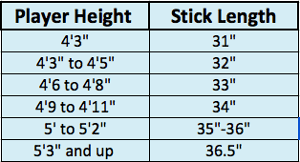- Since 1982, the Exclusive Distributor of Dita Field Hockey Products in the USA
- Email : DitaUSAoffice@gmail.com
SELECTING A STICK
Only Dita goods purchased from an AUTHORIZED DITA USA RETAILER are covered by warranty.

What shape stick should I choose? Why does stick height matter? How much carbon is right for me? Who knows how to fit me to my best stick?
Answer: Get the stick that helps you play hockey the best! Take the Stick Matcher Quiz!
Selecting a Size
Players under 5’2’’ should follow the sizing chart below to select an appropriate stick height, or a quick guide is to measure the stick to the top of the hipbone. What many do not hear in the USA is that this is just a quick estimate for little kids. Once a player reaches 5’3” the global standard is 36.5”. We highly suggest that players remain at 36.5” for the best field vision and control. There are many Elite and National Team players who are over 6 feet tall that still play with a 36.5” stick. Players with a more upright style, can move up in stick size at 5’10”. Those with a low-to-the-turf style (most NCAA coaches teach this) should stay with a 36.5” stick. A wider stance will allow better reach and hits while maintaining field vision as well as allowing for pulling the ball in close when maneuvering. Longer sticks can help goalies for shootouts and field players for drag flicks, but in general, longer sticks can cause a player to strike the ground during hits, play the ball further away from their body allowing easier access by opponents, and force them more upright reducing field vision.
Bend
The bend of a stick affects how it moves and lifts the ball. Smaller bend sticks, 22mm or less, are easier to develop core skills and result in less accidentally lifted hits and receptions. Medium bend sticks, 23mm, allow some maneuverability and lifts with the best shape for sweep hits and deceptive sweeps. Large bend sticks, 24-25mm, are easiest to perform more advanced techniques like aerials, drag flicks, 3-D skills and have better maneuverability overall, but can sometimes crate the angle for accidentally lifted hits and bobbled receptions. The Low (or Late) Bow is a sharp curve very low on the stick, the control in maneuverability and lifts make it the most popular shape. The Extreme Bow’s bend is not quite as low on the stick, but is often the largest curve, making it easier for drag flicks.
Head Shape
There are two main types of head shapes on a stick: J-shape and Maxi head. Many players prefer the J-shape since it has more playing surface and is easier to dribble; it allows players to pass and receive more upright. Forwards who need to get off quick passes typically prefer the J-shape. The head curves up to form the letter “J”. The Maxi head is the same size at the J-shape head, but doesn’t curve up as much, it has slightly wider sweet spot but dribbling is not as easy. Some sticks have shaved angles on the back of the head to allow the bottom edge of the stick to get under the ball and may provide a guide for a better angle on the stick face for lifting the ball.
Power/Carbon Amount
The amount of carbon in a stick dictates the potential energy for hitting the ball and how much deflection will occur. Less carbon levels will allow more control and forgiveness when trapping the ball. Higher carbon levels will allow more power and stronger deflections. Some prefer a stiff stick since it increases the player’s ability to use deflection to their advantage. Typically, less experienced players should start with a lower amount of carbon and then slowly work their way up as their skill level increases. If the ball bounces away during traps decreasing the carbon amount will help with ball control. Sticks made with a softer style of carbon, like the Exa brand, have as much power as an equivalent stick with the same carbon ratio but with a softer receive, keeping the ball closer to a player’s stick. Sticks made with a crisp style of carbon, like the Dita brand, are more responsive and have stronger deflection for those seeking a stronger tap dribble, crisp hit, or stronger sweep or tip-in on goal.
Weight
The weight of a stick can benefit different sets of skills that are preferred by different positions. Typically defenders prefer heavier sticks, or ones with a lower balance point, because it provides stronger block tackles and more momentum on drives. Offensive positions typically prefer lighter weight sticks, or ones with a higher balance point, since they allow quicker stick movement for dribbling. Aerials and 3-D skills are easier with less head weight. Sticks that are too light will not provide enough momentum to maximize the carbon, or potential energy, in the stick reducing hitting power.
How do I know which stick to get?
The Dita Stick Matcher Quiz can help players find their best stick match. Choose from Original, Collegiate or Indoor. Take the quiz more than once if you aren’t sure about a question. https://ditausa.com/stickmatcher.html






